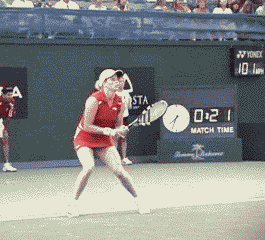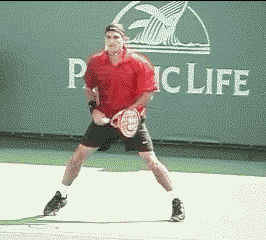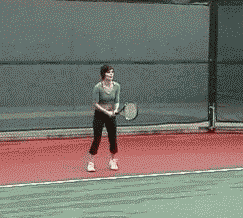|
TennisOne Lessons Skilled Tennis Achievement: Nature or Nurtured? Dave Smith TennisOne Senior Editor It is often mentioned by television commentators that many of today's top tennis players are blessed with athleticism and complementary genes, both of which they say have helped propel them to the top of their sport. And, in most cases, I would agree with them. However, it is often implied that many of them have developed into players who could hit great shots through some innate ability, as if this was some kind of natural evolutionary process. We have many teaching professionals advocating a philosophy that says, “let people discover tennis themselves,” or “by playing games and simply hitting thousands of balls in given situations, tennis players will fortuitously develop the necessary techniques to play the game well.”
While there are a few exceptions, these statements are simply not true for the vast majority of tennis players who prescribe to these philosophies. Ironically, I am a product of this philosophy, to a certain degree. While I did have a nationally recognized tennis coach for a father, I was a golfer up to the age of 13. When I started high school, I began to take an interest in tennis. Unfortunately, my father coached one of the schools I played against! So, while many thought my tennis success was directly related to the relationship with my father, I was never directly influenced by him on the court. (I would later become very influenced by him when I would become a coach myself!) I actually only had a handful of tennis lessons growing up. And, I also know several players who did indeed become skilled tennis players with minimal formal instruction. But, this is very misleading. While I and other such players may have reached higher levels of play with minimal formal instruction, we did have the means to learn proper technique another way. Self perception: Interpretation and Self-application
I have found in my thirty years of teaching that many players have a different propensity for two things directly related to learning any skilled activity:
When tennis players can examine tennis, whether it be on television, in person, or by utilizing the power of the information found on sites such as TennisOne, their ability to see the dynamic patterns that pros use to execute strokes is paramount in reaching skilled play. Unfortunately, many players don't have the keen observational abilities to see all the nuances and subtle stroke patterns, including grips, preparation phases, post contact follow-through patterns, and footwork patterns to clearly identify specific things they themselves need to work on. This is especially true today - the game has become so fast and the swing patterns so powerful and aggressive, it is much harder to identify such items. When I was growing up in Southern California, I was a very observant student of both the pro game as well matches tournament matches between much better players than I. It was much easier then to see the swing characteristics of a McEnroe, Connors, Evert, Laver, Borg, and others when watching on television. Likewise, tournament players of the day also played with a slower, more methodical swing path, making it relatively easy to identify specific stroke aspects for those of us who knew what to look for and could identify what we were seeing! The inability for many to interpret correctly and, then, apply this understanding to their own games, is one of the reasons so many players take tennis lessons. Many players may not be sure what they should be working on and many more are not sure if they—in turn—are doing the desired motions with accuracy and intent. One of the things I notice about players who are able to grasp tennis quickly is their ability to imitate very well. This goes, I suspect, for all sports.
Tennis players who can indeed mimic the movements—and even characteristics—of a favorite pro or skilled player are far more likely to master the game at much higher levels of skill. Yet, many players don't have the kinesthetic control to know exactly what their body is doing, especially when it comes to complex motor skills. I believe one of the problems when players take tennis lessons is the tendency to be completely dependent on the pro to provide the feedback, incentive, form, and evaluation. At my academy we try to get students to think about why they are doing specific movements. To me, education is an important part of the training process. For example, if I can get players to understand how the axis of spin of the ball for a serve will result in a serve that curves and behaves in a particular way, then they will be able to better figure out why a particular grip, swing path, or body position is important for such serves. I have taught many players who possessed limited natural ability go on to reach extraordinary high levels of play. So much so, that I personally believe every individual, barring some handicap (mental or physical) can indeed reach similar levels of skilled play. If fact, even the least athletically gifted players, given the proper training, can reach levels considered highly skilled. Four Conditions for Skilled Play I have touched on these four conditions before, but it is important for students to understand that any chance of becoming a skilled player hinges on ALL four of them:
As you can see, with the exception of Athleticism, the other three conditions are not driven through natural selection or genes! And, even with athleticism, this condition is probably the least important unless there is a specific handicap involved. Defining Potential Potential, by definition, means to reach a player's ability within one's means or capabilities. Unfortunately, a player's true potential is seldom met. Obviously, if a student is missing anyone of the above mentioned conditions, either through self design, circumstance, or misinformation, they probably will never reach their true potential. A player can have all the desire in the world, but if they are being misled through poor information, all the hard work in the world will generally result in limited success. This can explain why we have literally millions of players who languish at levels of play far below their potential. I have seen hundreds of players, who were gifted athletes, taught methods that, may have gotten the student ‘playing' tennis, failed to provide for long-term progressive improvement. Millions of such players are literally stuck—for a lifetime—at 3.0 or 3.5 levels of play.
Many of these players may have been given the proper instruction and even had plenty of athleticism to reach skilled levels. However, because the player would not trust the instruction or could not break habits or allow themselves to utilize the proper instruction to the degree that would allow them to master it, they failed to reach their potential. It is always interesting to me when I hear a coach, teaching pro, or even another player lament on the virtues of some player who reached a relatively high level of play. I'll get coaches who say, “I've got a kid who learned to volley and serve with eastern grips, hit forehands with his wrist, and step with the wrong foot on the forehand and yet, he is number three in Timbuktu!” My response to this is, “I wonder how good he could have been with proper technique?” While we will never be able to tell if someone like this really could have been better by using different techniques, I have seen without a doubt—and without exception—that those players taught tennis using proper techniques tend to come closer to reaching their potential. Potential Unrealized Tennis is an interesting sport. It is also a sport that reveals a lot about our current society. Today, people want to experience ‘success' quickly and with as little frustration as possible. One of the reasons I got out of public education was the continued ‘dumbing down' of education in the public classroom. Read almost any tennis book today, and you will see this same ‘dumbing down' of tennis. Books and even a great number of tennis instructors teach within a philosophy that provides for fast and easy learning. You will see this concept hidden in such phrases as: “The beginner player can use the eastern grips on the volley. They are easier. Advanced players use the continental.” Or: “It is OK to use the eastern forehand grip for serving. If you want to remain competitive, you will want to switch to the continental grip.” I have over a hundred books that use these same general phrases. The problem with this methodology is that making changes in tennis techniques is incredibly hard. I have always questioned this teaching mantra. Why would you want to spend any amount of time learning something you will have to change later? Ask any frustrated player who has learned tennis this way and is stagnant at a level far below their potential will attest to, changing technique is quite frankly one of the hardest things a person can attempt. Thus, anyone who picks up a tennis racquet and wants to see how good they can become will want to avoid learning techniques that MUST change for skilled tennis to be achieved. I developed a method called the Advanced Foundation that promotes learning techniques that not only avoid the necessity for change, but allow for player evolution to occur You can teach a hundred players the same service technique, yet no two players will end up with the exact same serve. Teaching proper techniques to all players will never produce clones. All players will self-define stroke characteristics and evolve this ‘foundation' to not only meet personal preferences, but also meet personality needs. All achieve individuality within the same foundation. This should explain why the pros have similar stroke components, yet play with distinctively different idiosyncrasies and personalities. This should also explain why a top-level teaching pro can produce many top-ranked players, yet all of them play a little differently! Conclusion I hope that this article has inspired each of you to realize that you have the potential to become, quite frankly, as good as you want to be. The fact that few—if any—top level pros were born to such promise should encourage all of you to believe in yourselves and pursue any dreams you want….tennis or otherwise! Your comments are welcome. Let us know what you think about Dave Smith's article by emailing us here at TennisOne .
TENNIS MASTERYFinally. a resource that unlocks these mysteries: • Why do m • Why are making changes in one's game so frustratingly difficult? • What tennis teaching methods are disruptive or detrimental to player progression? Read David W. Smith's TENNIS MASTERY and learn not just how to avoid playing at mediocre levels, but how the best players in the world Master the sport of tennis! "With a depth of knowledge and fresh perspective, TENNIS MASTERY is set to become a manual for tennis instructors and a measure for tennis literature." Richard Wigley, Director, Kayenta Tennis Center , Ivins Utah . Take in David Smith's 30 plus years in the tennis teaching industry. This 335-page manual will provide for every level of player as well as support for all tennis-teaching professionals, a blueprint for reaching higher levels of tennis mastery. Order TENNIS MASTERY at tenniswarehouse.com , or go to tennismastery.net for exciting excerpts from the book and a host of tennis information! And check out David Smith's other articles found here at TennisONE.com David has taught over 3000 players including many top national and world ranked players. He can be reached at acrpres1@email.msn.com. |




 illions of tennis players stagnate at levels far below their potential?
illions of tennis players stagnate at levels far below their potential?  Your comments are welcome. Let us know what you think about this article by
Your comments are welcome. Let us know what you think about this article by